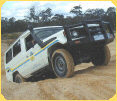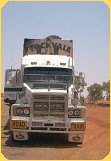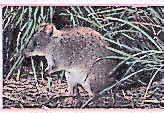 |
 |
|
|
|
||
|
Outback Info (Private Seiten) © seit 1999 Das Kangaroo / Arten
Kangaroos are Australia's best-known animals. Since they were first seen by European settlers - who were amazed at such strange animals - a lot has happened to these unique creatures. There are now more of some kangaroo species, generally the larger ones, than when the European settlers arrived. Other species are gone forever, made extinct by surroundings that were changed too much for them to survive. Many of the surviving species are also decreasing in number. They, too, may become extinct if we do not take the necessary actions.
Kangaroos, and their close relatives, vary greatly in size, ranging in weight from 500 grams to 90 kilograms. There are at least 69 different types of kangaroo, called species. These species are found naturally in the wild only in Australia and New Guinea, although feral populations of some species have been introduced in New Zealand, Great Britain and Hawaii. Recently, scientists have separated these species into two families (the Macropodidae and the Potoroidae) which together form a super-family known as the Macropodoidea (or macropods). The family Macropodidae includes kangaroos, wallabies, wallaroos, pademelons, tree-kangaroos and the forest wallabies of New Guinea. The family Potoroidae is made up of potoroos, rat-kangaroos and bettongs which are only found in Australia. The best-known macropods are kangaroos, which is why the word 'kangaroo' is often used to describe any of the members of this family. We use "kangaroos' in this brochure whenever these animals are being discussed in general. Kangaroos of all sizes have one thing in common - powerful back legs with long feet. They are distinguished from other animals by the way they hop on these strong back legs. Only a few other small mammals, such as hopping mice, do this. Hopping uses slightly less energy than four-footed running, but this advantage is lost at low speed. To move slowly, kangaroos balance on their front paws and tail, and then swing their hind legs forward in a pendulum motion. One of the many odd things about kangaroos is that, on land, they can only move their hind feet together but when swimming they can kick each leg independently. Tree-kangaroos can move each hind leg separately when climbing. It is also interesting to note that, while several species of kangaroos have tails that can wrap around and carry nesting material such as grass and small branches, not one of the tree-kangaroos has the ability to grasp branches with its tail. Development of the Young in the Pouch Kangaroos have adapted to the varied conditions across Australia in many ways. One of the most unusual, is the way females of some species can delay the progress of pregnancy. In this way the female is ready to give birth to a replacement for her pouch young if it dies early, or within a week when it permanently leaves the pouch. This ability to delay births means that there can be up to 12 months between a mating and the birth of the young one resulting from that mating (when the normal gestation period is less than 35 days). It also means that the species can best respond to periods of drought and plenty. Species which have this unusual ability normally mate again soon after the female gives birth. The tiny newly born kangaroo (less than 25 mm long) moves unaided into its mother's pouch and attaches itself to one of four teats. During the early stages of pouch life the young is permanently attached to the teat, but as it matures and begins to grow hair it also develops the ability to release and reattach itself to the teat. In the late stages of pouch life, once it has a thin covering of fur, the young one begins to explore the outside world for increasing lengths of time until eventually it is old enough to be excluded permanently from the pouch. Complete weaning may take a number of months more after the young has permanently left the pouch. If the mother gives birth during this time, the newborn young will attach itself to a different teat to that being used by the older young. It is remarkable that when this happens the mother produces two different kinds of milk for the two different-aged young. Different Species for Different Habitats Australia is a large country with a wide range of landscapes and climates. Yet kangaroos, rock-wallabies, pademelons, rat-kangaroos, potoroos and others have found all sorts of living areas, or habitats, to suit them across the continent. There is no real difference between the kangaroos and wallabies that form this family - other than size. Wallabies are generally smaller species, with none weighing over 25 kilograms. Wallaroos (or euros) prefer a habitat of steep, hilly country. On the other hand, the larger kangaroos prefer open flat plains, woodland or open forest. Members of this family are generally grass and leaf eaters, able to convert dry grass into energy-giving glucose. Their ability to thrive on such a poor diet explains their success at living in so many parts of Australia. The Red Kangaroo (Macropus rufus), is the largest living marsupial. Males can be as tall as two metres and weigh up to 90 kilograms. The animal can live in most of dry inland Australia, including desert, grassland, mallee and mulga country. It is able to go without drinking as long as green grass is available, and it adapts well to drought. Despite its name, the Red Kangaroo is sometimes a blue - grey colour, particularly the female. Together with the Eastern and Western Grey Kangaroos (Macropus giganteus and Macropus fuliginosus), these are the largest and best known of the kangaroos. The Eastern and Western Grey Kangaroos The Eastern and Western Grey Kangaroos live where rainfall is greater than 250 millimetres a year, through eastern Australia and across the southern coast to south-west Western Australia. Populations vary considerably according to conditions, but the two species are very common, except in Tasmania where small numbers of the Eastern Grey Kangaroo are found. There are three species of wallaroos. The common Wallaroo (Macropus robustus) is found throughout mainland Australia and has a preference for rocky hills and stony rises where caves and rock ledges provide shelter from extremes of temperature. The Black Wallaroo (Macropus bernardus) in contrast is restricted to a small area of central and western Arnhem Land in the Northern Territory. The Antilopine Wallaroo, (Macropus antilopinus) is found in the tropical monsoonal forests of Northern Australia where it replaces the Red and Grey Kangaroos. Tree-kangaroos are adapted to living in trees. They have stronger front limbs than other kangaroos, shorter hind legs, and feet with a rough-textured sole to allow for a better grip. Despite these features, they are awkward in trees. Most species are found in the dense forests of New Guinea. The two Australian species - Lumholtz's Tree-kangaroo (Dendrolagus lumholtzi) and Bennett's Tree-kangaroo (Dendrolagus bennettianus) - are found in small areas in the tropical rainforests of north Queensland. They feed on leaves and fruit. Hare-wallabies look a bit like European Hares. They also have the European Hare's habit of hiding in tufts of grass. There are five known species of hare-wallabies. Of these, the Eastern Hare-wallaby (Lagorchestes leporides) is already extinct, and the Central Hare-wallaby (Lagorchestes asomatus) possibly so. Only one species, the Spectacled Hare-wallaby (Lagorchestes conspicillatus) is still widespread. Hare-wallabies mostly prefer tropical plains and grassland. These wallabies are so named because of the horny spur they have at the end of their tails. There are three species of nail-tail wallabies. One, the Crescent Nail-tail Wallaby (Onychogalea lunata) is extinct. The Bridled Nail-tail Wallaby (Onychogalea fraenata) is found only in a small area around Dingo in Queensland. The Northern Nailtail (Onychogalea urguifera) is found across the top end of Australia and is still common. Rock wallabies are a large group of quite different-looking species. As their name implies, they prefer rocky regions. They are found throughout Australia. Because they prefer rocky gorges, cliffs and boulder jumbles, populations may be confined to widely separated and small areas. The most beautiful and strikingly coloured of all macropods is the Yellow-footed Rock Wallaby (Petrogale xanthopus). Competition with feral goats is a problem for rock wallabies in many areas, and we believe foxes have reduced the numbers of some rock wallaby species. The Nabarlek (Petrogale concinna) is the smallest of the rock wallabies. It is unique among all marsupials in that it can continue to produce more than the normal four molar teeth. It prefers grasses rich in silica, and this abrasive food may explain why the animal can continually replace its grinding teeth.
Pademelons are small wallabies that live in wet forest areas. There are three species in Australia: the Red-legged, Red-necked and the Tasmanian Pademelon (Thylogale stigmatica, T. thetis and T. billardierii). All live in rainforests or wet forests along the east coast and in Tasmania. The Tasmanian Pademelon is noted for its fine fur. It was once hunted in great numbers, but remains abundant today. Pademelons prefer similar habitats to potoroos, but have a different diet - they eat juicy grasses and shrubs. All three species remain common. Potoroids are smaller macropods and were once called the rat-kangaroos. Some, such as the Musky Rat-kangaroo (Hypsipymnodon moschatus) of north Queensland rainforests are no bigger than a rat, and others grow to the size of a rabbit. Potoroids have an unusual diet - of mushrooms, roots, and insects. Mostly, they live in dense undergrowth and make nests from material carried by curling their tails around it. However, this is not always the case. Even though it has not been seen since 1935, the Desert Rat-kangaroo (Caloprymnus campestris) lived in one of the hottest, driest and most exposed areas in Central Australia. Many of these small species have been badly affected by European settlement. Their preferred habitat has often been cleared for farming, and they have had to deal with the effects of many introduced animals, such as the fox, the cat and the rabbit. Two species of potoroids (there are nine known in all) are already extinct. Two more now survive only on coastal islands and another is rare. Potoroos are mainly found in the wet forests and heathlands of east and south-east Australia. They feed in the open, but retreat to thick undergrowth for protection. The rare Long-footed Potoroo (Potorous longipes), is found only in the forests of east Gippsland and south-eastern New South Wales. The broad-faced pottoroo (Potorous platyops) was found in south-western Australia, but has not been recorded since 1875. Interestingly, Gilbert's Potoroo, the western Australian race of the Long-nosed Potoroo (Potorous tridactylus) was recently rediscovered in south-west Western Australia after an absence of more than 80 years. Bettongs are found in drier areas than those preferred by the potoroos. Like most small macropods found in arid areas, bettongs are active at night to avoid moisture loss during the heat of the day. The Burrowing Bettong (Bettongia lesueur), does not drink. It gets the moisture it needs during the night from juicy sandhill plants. One of the endangered species of bettongs, the Brush-tailed Bettong (Bettongia penicillata), has been bred and released on islands off the coast of South Australia in a program supported by the Australian Government. Only two species, the Tasmanian Bettong (Bettongia gaimardi) and the Rufous Bettong (Aepyprymnus rufescens), can be regarded as common. Even so, they are found over a smaller area than before, due mainly to clearing of their habitat for farms.
Of the 53 species of macropods found in Australia, six have become extinct since European settlement. For another 11 species, the area in which they are found has declined to less than half of what it was in that same 200 years. Research and re-establishment programs A lot of valuable research has been carried out into the habitat needs of declining species. But there is still much more to do. The Australian Government has assisted research and re-establishment programs for species such as the Bridled Nail-tail Wallaby, the Brush-tailed Bettong and the Rufous Hare-wallaby (Lagorchestes hirsutus). Management, Protection and Commercial Harvesting Management methods, such as deliberate control of fire patterns, have been tried on a small scale for particular species. All species of macropod are protected from hunting by state and territory legislation, except for a small number of large species for which commercial harvesting is permitted under approved management programs. The greatest threat to all macropods, however, is reduction or complete destruction of the habitats upon which they depend. This is particularly important for the smaller species where legislation to protect vegetation, such as the Vegetation Retention Scheme in South Australia, is more likely to help ensure their continued survival. National parks and nature reserves have been important in helping to protect and re-establish some species, especially those that include the offshore islands of Western Australia. These islands are now the main, or only sites, of several species of macropods. But it is not always enough just to declare a reserve. Active management, including deliberate habitat changes, may be needed for some species. Farmers and graziers have an important role to play in preserving macropods and other Australian wildlife. The Wallaby Creek area in north-eastern New South Wales has an unusually large number of different macropods - eleven species. There are no conservation reserves in the area, and it is used for light cattle grazing and timber production. Understanding why so many macropod species can live in this area, which is also being used for primary production, could help conservation in other areas outside of the reserve system. About 75 per cent of Australian animal species are found only in Australia. Our kangaroos, wallabies, potoroos, pademelons, rat-kangaroos and the others are an essential part of our unique heritage. They can only be preserved by protecting the whole range of habitats found in Australia. European settlement of Australia has worked against the survival of many native animals, including some species of kangaroo, in four main ways: fire patterns have changed, domestic stock have grazed large areas of native habitat, new predators have been introduced, and land has been cleared. Each of these factors has had a major, though different, effect on the habitat of our native species. For example, the various hare-wallabies have:
Australia's arid environment is most fragile and here the impact of Europeans has been most drastic. Past distributions show that the arid areas favoured either large or small macropods - not the midsize species. Then, with the arrival of the fox and cat, the advantage of being small also vanished. Hume, I. D., Jarman, P. J., Renfree, M. B. and Temple-Smith, P. D. (1989). 'Macropodidae'
in Walton, D. W. and Richardson, B. J. (eds), Seebeck, J. H. and Rose, R. W. (1989). 'Potoroidae' in Walton, D. W. and
Richardson, B. J. (eds), Strahan, R. (ed.) (1983). The Australian Museum complete book of Australian
mammals. The National Photographic Index of Australian Wildlife. Brochure was produced March 1995
|
||||||
Schatzsuche in Down Under / Fossicking
|
||||||||||||||||||||||||||||||||||||||||||||||||||||||||||||||||||||||||||||||||||||||||||||||||||||||||||||||||||||||||||||||||||||||||||||||||||||||||||||||||||||||||||||||||||||||||||||||||||||||||||||||||||||||||||||||||||||||||||||||||||||||||||||||||||||||||||
Australien-Kanal.de © seit 1999, Fossicking.de © seit 1999






